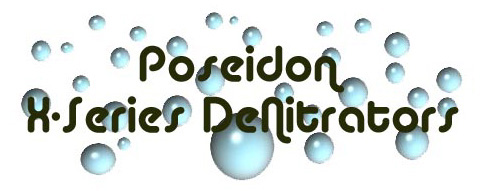1801 S. Nova Rd., S. Daytona, FL 32119
386.255.3474
386.ALL.FISH
Nitrates are a natural product of the nitrogen cycle. Once an aquarium is "cycled", ammonia and nitrites are converted into small amounts of nitrate. Nitrate levels are usually low and are filtered out naturally through denitrifying bacteria called anaerobic bacteria. However, nitrate levels can sometimes build up from overfeeding, overcrowding, not enough water changing, and even the breakdown of the anaerobic bacteria bed itself. High nitrate levels can be toxic, and can poison your fish and cause tissue decay in coral.
The anaerobic bacteria breakdown in your aquarium can be due to a number of factors. This type of bacteria forms where low oxygen concentration levels occur inside the aquarium. Since in an aquarium we typically add powerheads and try to maintain good water movement throughout, the anaerobic bacteria would normally be found in the bottom layers of your substrate where water flow is less pronounced. Depending on the type of substrate and its thickness, a certain biological proccess begins when the aquarium is first set up and goes through its cycle. As the addition of new livestock begins, the anaerobic bacteria undergoes a changing proccess itself. Bacteria lives and dies out just like any other living organism. If the anaerobes do not get enough to eat, they will die out themsleves contributing to the nitrate production in the tank. Sometimes only so much bacteria can form due to volume restrictions and can only filter out nitrates to a certain extent.
The Poseidon X-Series nitrate reducing filters, create additional housing for anaerobic bacteria to thrive upon. This bacteria will eat up nitrates and the feed from the bio food provided all within each canister.
Poseidon X-Series DeNitrators are highly efficient and economical nitrate reduction filtration systems designed to remove nitrates from the aquarium using a natural anaerobic denitrification process. The X-series denitrators ARE NOT coil denitrators. Coil denitrators produce sulfuric acid and sulfide gas byproducts that are toxic to animal life. A simple and safe reaction of Carbon Dioxide and Water are the main derivatives for the X-series denitrators with no harmful side affects. The X-series denitrators house an enormous surface area for denitrifying bacteria to thrive upon. Furthermore a specially designed bioplastic media (included) feeds the bacteria for a period of 18 months! During this time no extra feedings are necessary!
Some DeNitrators mainly require dangerous alcohol feedings to boost the levels of anaerobic bacteria within their volume. This can have an adverse effect by vastly increasing the levels of harmful aerobic type bacteria leading to harmful pathogenetic effects (Coral Bleaching, Cyanobacteria) as well as dangerous levels of phosphates and sulfide gas as a byproduct.
After the 18 month grace period, the media in the X-series denitrator does not necessarily need changing unless the nitrate levels start creeping up again.
These filters can be used safely on all Freshwater (including Planted Aquariums) as well as Saltwater Aquariums (especially Reef Systems). Using a X-series denitrator will reduce the amount of water changes on your system saving you both time and money. Not to mention a clean and healthy environment for your underwater friends.
Nitrates in the aquarium can be controlled by frequent water changes, along with limiting the biological load and excessive feedings. A well vented wet dry, or biological filtration system will detoxify ammonia before it breaks down into nitrate. Utilizing chemical filtration, and protein skimming will also limit nitrate levels.
Systems with excessive nitrates tend to have similar characteristics which may include one or more of the following:
a) Use of chlorinated tap water. There are high traces of chlorine, chloramines, ammonia, fluorine, and other toxins
found in tap/city water. There are also an over abundance of minerals and metals (some harmful) found in tap
water as well. The aquarist usually uses a water conditioner to "remove" the harmful chlorine, chloramines, and free
ammonia that can kill fish instantly, but they do not realize that they are also compounding the heavy metals and
minerals from the tap water that do not get "removed" by water conditioner they are using. Furthermore, the water
conditioner itself after detoxification occurs leaves a residual binded non-toxic compound that inevitably gets broken
down within the biological food chain of the aquarium. The excessive buildup of minerals will form algae and
increase nitrate levels as they get broken down. One very simple method to keep this in check is to use filtered water
or reverse osmosis water. Using RO water along with the proper buffering agents will help keep you nitrates low.
b) The types of food used by the aquarist can cause nitrate issues. Besides overfeeding (which is a given), the quality of
the food given to the fish plays a major roll with nitrate issues. Foods that are not really food but have lots of filler
ingredients should be avoided at all costs. These fillers break down faster than what the fish can eat and just become
another mineral supplement for the aquarium biological food chain to break down. Use high quality frozen, pellets,
as well as flake for feeding. Do not overfeed.
c) Excessive biological housing. The total biological housing capacity (live rocks, bio balls, bio - media, sand/gravel)
minus the total amount of biological matter (fish, plants, corals, inverts) equals the nitrates formed. It is a simple
equation that requires lots of checks and balances to keep nitrates low.
The live animals in your tank will eat, and produce waste in the aquarium. The biological food chain which consists of
bacteria, eat the waste and eventually convert it into a less toxic form, nitrogen gas. The bacteria cannot live without
waste, and likewise the live animals cannot live without the bacteria cleaning up after them.
Systems that are overstocked with live animals and do not have enough biological housing will experience nitrate
issues. Similarly, systems that have high amounts of bio-media and are not that heavily stocked with live animals can
experience nitrate issues as well.
d) Anaerobic bacteria presence. Bacteria lives and dies on a constant basis and its population changes every day in the
aquarium. One type of bacteria that eats up nitrates is call anaerobic bacteria. This bacteria does not like the
presence of high oxygen concentrations. Systems that tend to overfiltrate have a tendancy to not have an abundant
amount of this type of bacteria that helps reduce nitrates. Biological filtration usually forms the oxygen liking aerobic
bacteria which detoxifies ammonia and nitrites quite efficiently. However, its byproduct (nitrates) remains in the
system for the slower anaerobic bacteria to take care of.
The X-Series DeNitrators are very compact in size and will fit under all aquarium cabinets (for individual sizes, please see the specific denitrator model). The filters promote the growth of anaerobic bacteria by creating an enormous surface area for the bacteria to live and help sustain it with a specially designed biological carbonate food source (included). There are no extra feedings required to the media.
The X-series denitrators safely and effectively accelerate the reduction of nitrates into nitrogen gas. They will maintain LOW to NO Nitrate levels for many months before media exhaustion.
Replace with (Denitrification media packs) after nitrate levels begin fluctuating to higher than normal again. The media in does not need replacement for over 18 months!
Please visit the individual DeNitrator (X-1, X-2, X-3 ) and its instruction guide for more information regarding the product.
X-1 DeNitrator rated for aquariums up to 75 gallons (284L)
X-2 DeNitrator rated for aquariums up to 180 gallons (680L)
X-3 DeNitrator rated for aquariums up to 300 gallons (1130L)


